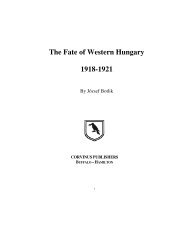The Tsangos of Romania - Corvinus Library - Hungarian History
The Tsangos of Romania - Corvinus Library - Hungarian History
The Tsangos of Romania - Corvinus Library - Hungarian History
Create successful ePaper yourself
Turn your PDF publications into a flip-book with our unique Google optimized e-Paper software.
were no <strong>Hungarian</strong> priests and in 1744, they wrote to the HolySee immediately the result <strong>of</strong> which was a law, stating that only<strong>Hungarian</strong>s could go to Moldavia and three priests were sent atonce. Unfortunately this law was not carried out and no morepriests were sent.One time a <strong>Hungarian</strong> Jesuit, Beke Pál, wanted to preachin a town but was driven out by two Italian missionaries whoattacked Beke with axes, forcing him out <strong>of</strong> the church and awayfrom the people.MÁDÉFALVAIn 1761, Mária Terézia, sent her general Buccon to Csik,Transylvania to enlist the Székelys. <strong>The</strong> Székelys felt that thisviolated their rights and they assembled in Csikmádéfalva toprotest. But on the 6th <strong>of</strong> January, in 1764, the armysurrounded the town and in the battle over 40,000 Székelyswere killed. That day became known in history as theSICULICIDIUM ( if we add the Roman numerals found in theword except S, I-1, C-100, U-5, L-50, D-500, M-1000, thenwe get the date 1764) which means: killing <strong>of</strong> Székelys. ThoseSzékelys, who had survived, were hunted from then on by themembers <strong>of</strong> the Criminalis Comission that was set up by theQueen. Many participants left Transylvania and settled inMoldavia. <strong>The</strong> most important organizer <strong>of</strong> the events <strong>of</strong>Mádéfalva was a priest, Péter Zöld who also fled to Moldavia.Péter Zöld, wrote several touching letters about the lives <strong>of</strong> theCsángós. He was shocked by the life-style <strong>of</strong> the Polishmissionaries who were greedy and useless. In one <strong>of</strong> his lettershe wrote about a visit to a village where the people had not seena priest for seventeen years. He described their joy anddevotion. He spent fourteen days in the village baptized,married, taught, and held masses. In 1768, the Székelys werepardoned and they could return to their homes, and that is whatPéter Zöld did as well.<strong>The</strong> pope, meanwhile, had been getting letters from allsorts <strong>of</strong> people who complained about the Italian priests, and in1774, he issued an ordinance which stated that all misionarieshad to take a <strong>Hungarian</strong> exam 6 months after their arrival toMoldavia. This would have been an excellent ordinance, butunfortunately, it was not carried out. This fact was also broughtto the attention <strong>of</strong> the pope, who in return sent two <strong>Hungarian</strong>
















